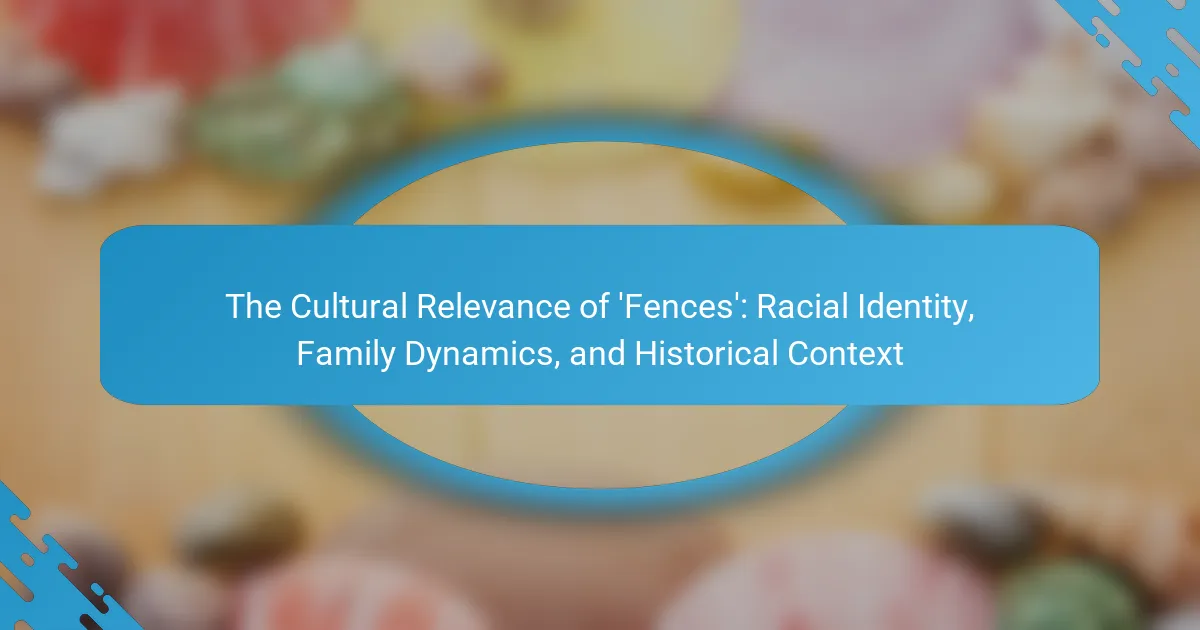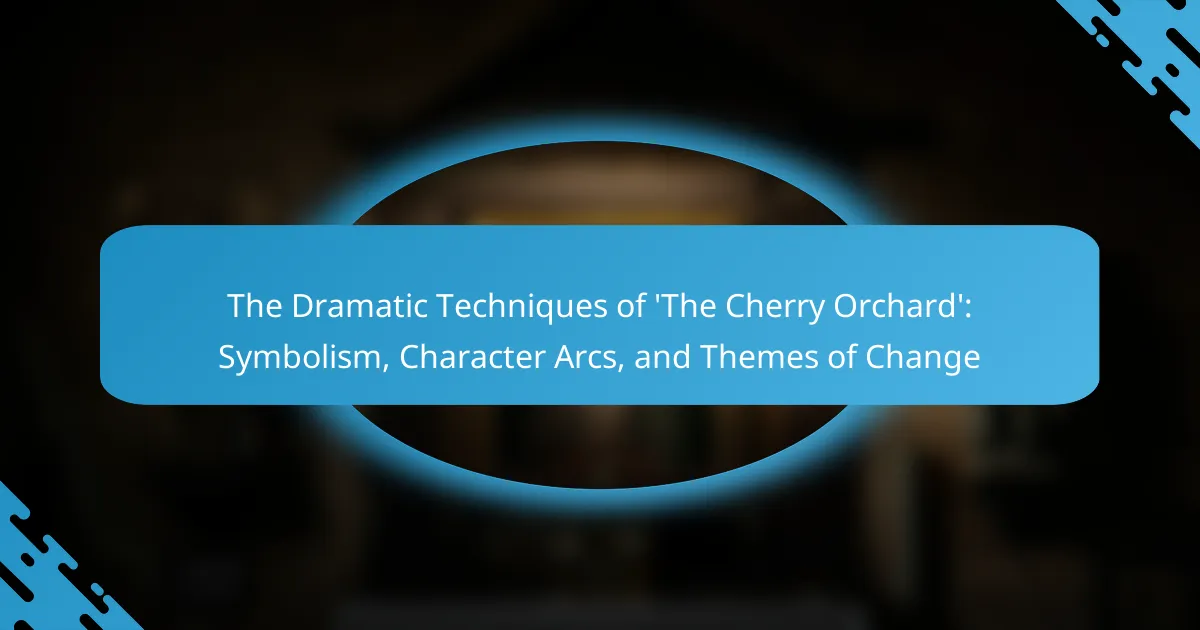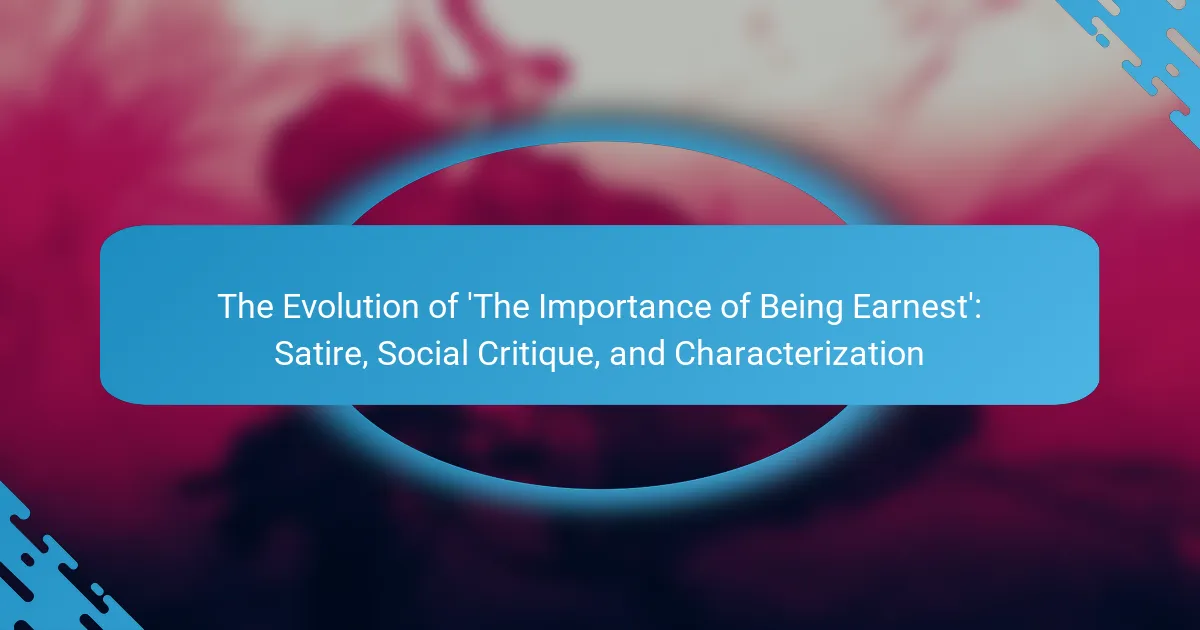‘West Side Story’ is a landmark musical created by Leonard Bernstein and Stephen Sondheim, first premiered in 1957. This production is notable for its innovative blending of music, dance, and narrative, addressing significant themes such as racism and love through a contemporary adaptation of Romeo and Juliet. It showcases the cultural tensions between the Jets and the Sharks, representing the struggles of white and Puerto Rican communities in the 1950s. The musical’s choreography incorporates ballet and jazz, setting new standards for movement in theatre, while its iconic score features songs that have become integral to American music. Ultimately, ‘West Side Story’ serves as a poignant commentary on social issues, emphasizing the importance of empathy and understanding in the face of cultural divides.
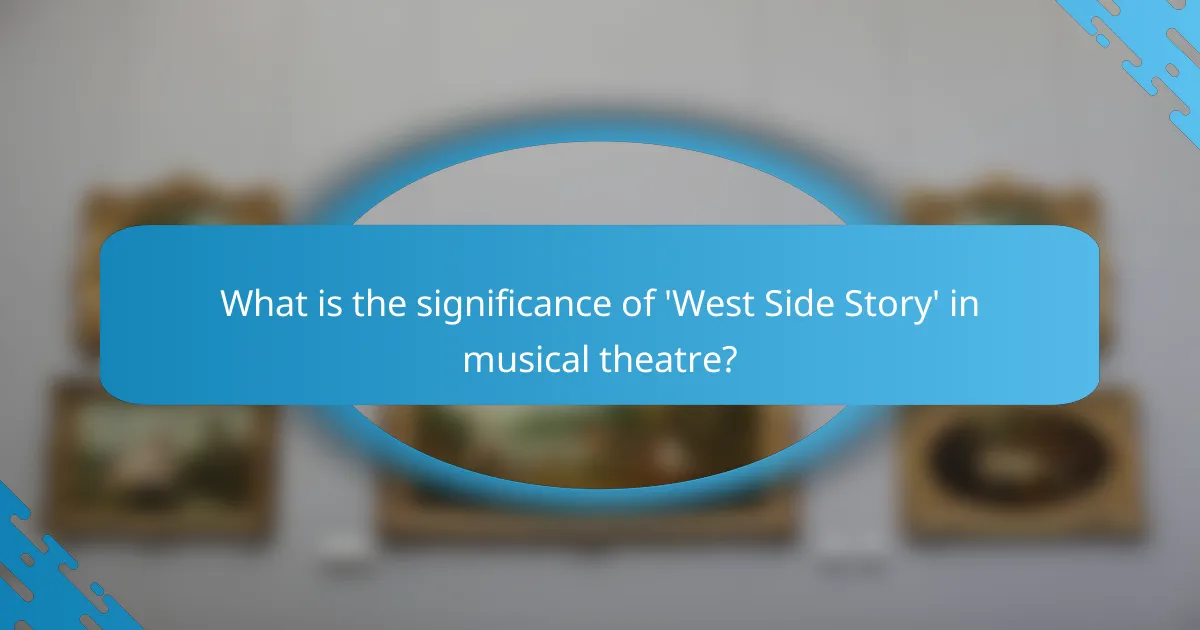
What is the significance of ‘West Side Story’ in musical theatre?
‘West Side Story’ is significant in musical theatre for its innovative integration of music, dance, and storytelling. The musical, created by Leonard Bernstein and Stephen Sondheim, premiered in 1957. It redefined the genre by addressing serious themes such as racism and love through a modern retelling of Romeo and Juliet. The use of ballet and jazz elements in choreography set a new standard for movement in musicals. Additionally, the score features iconic songs that have become standards in American music. The production’s impact on social issues and its reflection of urban life resonate even today. ‘West Side Story’ has influenced countless artists and remains a cornerstone of musical theatre history.
How did ‘West Side Story’ revolutionize musical storytelling?
‘West Side Story’ revolutionized musical storytelling by integrating dance, music, and narrative in a cohesive manner. It elevated choreography to a primary storytelling tool, reflecting character emotions and plot developments. The use of Leonard Bernstein’s complex score combined with Stephen Sondheim’s innovative lyrics added depth to the characters’ experiences. The musical addressed social issues such as racism and class conflict, making it relevant and impactful. Its structure broke away from traditional musical formats by incorporating a more dramatic and cohesive storyline. The characters were portrayed with psychological depth, enhancing audience connection. ‘West Side Story’ set a new standard for future musicals, influencing the genre significantly. This groundbreaking approach changed how stories could be told through music and dance.
What are the key musical elements that define ‘West Side Story’?
The key musical elements that define ‘West Side Story’ include its innovative use of rhythm, melody, and orchestration. The score, composed by Leonard Bernstein, features a blend of jazz, Latin, and classical influences. Syncopated rhythms create a sense of urgency and tension throughout the musical. Melodic lines often reflect the emotional states of the characters, enhancing the storytelling. The use of motifs represents different groups, such as the Jets and Sharks, adding depth to the narrative. Additionally, the integration of dance and music is crucial, with choreography by Jerome Robbins that complements the score. Overall, these elements work together to create a dynamic and emotionally resonant experience.
How do the musical elements enhance the narrative of ‘West Side Story’?
Musical elements enhance the narrative of ‘West Side Story’ by conveying emotions and advancing the plot. The score, composed by Leonard Bernstein, integrates various musical styles to reflect the characters’ backgrounds. For example, the use of jazz and Latin rhythms emphasizes the cultural divide between the Jets and Sharks. Songs like “Something’s Coming” express the anticipation and hope of the characters. The choreography, paired with the music, visually narrates the tension and conflict inherent in the story. Additionally, lyrical content reveals character motivations and inner struggles. The dramatic use of music during key scenes intensifies emotional impact, such as the haunting melodies in “Tonight.” Overall, these musical elements are crucial in deepening the audience’s understanding of the narrative and its themes.
What themes are explored in ‘West Side Story’?
‘West Side Story’ explores themes of love, conflict, and social division. The central love story between Tony and Maria highlights the power of love amidst adversity. Conflict arises from the rivalry between the Jets and the Sharks, representing broader social tensions. The musical also addresses issues of racism and cultural identity. Additionally, it reflects the impact of violence on communities. These themes are woven throughout the narrative, emphasizing the struggles of young people in a divided society.
How does ‘West Side Story’ portray the theme of love?
‘West Side Story’ portrays the theme of love through the intense relationship between Tony and Maria. Their love transcends the violent rivalry between the Sharks and the Jets. The musical illustrates love as both passionate and tragic. The iconic song “Tonight” expresses their hope and longing. Their love is depicted as pure, yet it faces societal obstacles. The tragic ending emphasizes love’s vulnerability amid conflict. This narrative showcases love’s power and fragility in a divided world. The story ultimately highlights love’s potential to inspire change, despite its challenges.
What conflicts are central to the storyline of ‘West Side Story’?
The central conflicts in ‘West Side Story’ are between rival gangs, the Sharks and the Jets. This rivalry stems from cultural and ethnic tensions. The Sharks represent Puerto Rican immigrants, while the Jets are a white American gang. Their conflict is exacerbated by territorial disputes in New York City.
Additionally, there is a personal conflict between Tony, a Jet, and Maria, the sister of the Sharks’ leader. Their love transcends gang boundaries but faces opposition from both groups. This romantic conflict highlights themes of love versus loyalty. The story ultimately explores the tragic consequences of these conflicts, leading to violence and loss.
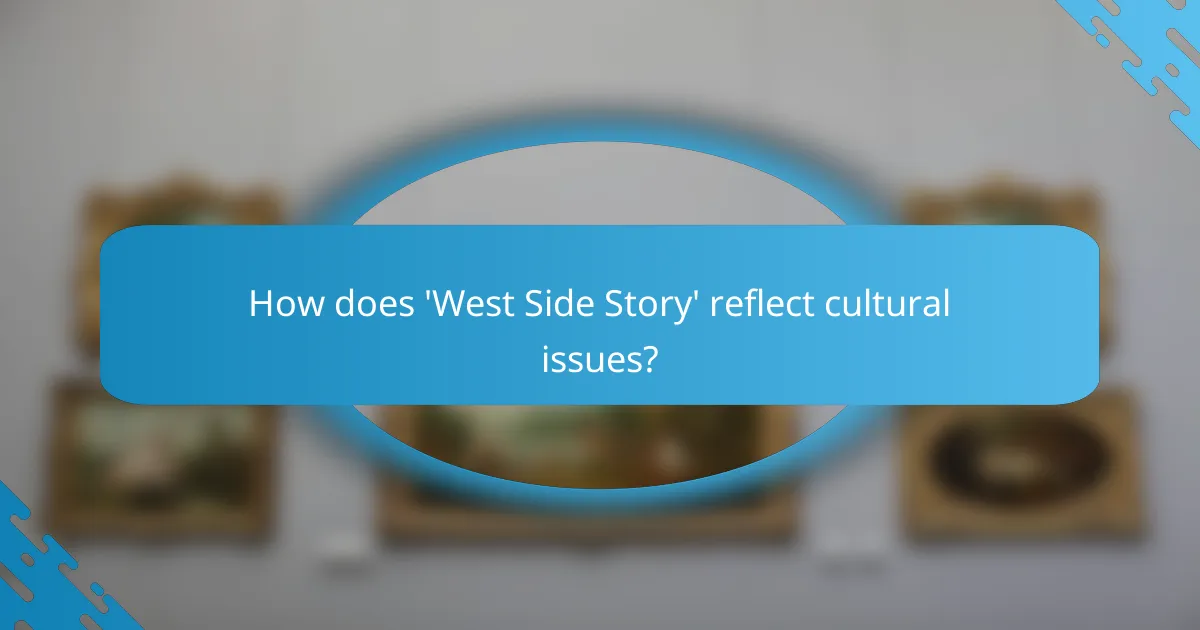
How does ‘West Side Story’ reflect cultural issues?
‘West Side Story’ reflects cultural issues through its portrayal of racial tension and social conflict. The musical highlights the struggles between the Jets and the Sharks, representing white and Puerto Rican communities. This conflict mirrors real societal issues of the 1950s, including immigration and discrimination. The characters face prejudice, showcasing the impact of cultural identity on personal relationships. Additionally, the use of music and dance emphasizes cultural expression and the clash of backgrounds. The narrative ultimately addresses themes of love, violence, and the desire for acceptance, making it a poignant commentary on cultural divides.
What social issues are highlighted in ‘West Side Story’?
‘West Side Story’ highlights social issues such as racism, gang violence, and immigration. The narrative contrasts the lives of two rival gangs, the Sharks and the Jets. This rivalry is rooted in ethnic tensions, showcasing the discrimination faced by Puerto Ricans in America. The musical also addresses the impact of violence on communities. Characters experience loss and heartbreak due to gang conflicts. Additionally, the story reflects the struggles of immigrants seeking acceptance. These social issues are interwoven throughout the plot, illustrating their relevance in society.
How does the setting of ‘West Side Story’ contribute to its cultural commentary?
The setting of ‘West Side Story’ plays a crucial role in its cultural commentary by highlighting urban conflict and social divisions. The backdrop of 1950s New York City serves as a microcosm of American society. It showcases the tensions between different ethnic groups, primarily the Puerto Rican Sharks and the American Jets. This setting reflects real historical issues of immigration and assimilation faced by minority communities.
The use of the cityscape reinforces themes of displacement and belonging. The characters navigate a landscape marked by violence and prejudice. This environment amplifies the tragic consequences of their rivalry, illustrating the impact of systemic social issues. The gritty urban setting contrasts with the idealized notion of love, emphasizing the barriers that exist in society.
Overall, the setting is integral to understanding the cultural commentary of ‘West Side Story,’ as it frames the narrative within the context of real societal struggles.
In what ways does ‘West Side Story’ address immigration and identity?
‘West Side Story’ addresses immigration and identity through its portrayal of rival gangs, the Jets and the Sharks. The Sharks represent Puerto Rican immigrants, highlighting their struggles and cultural identity. The musical illustrates the challenges immigrants face in adapting to a new society. It also showcases the clash of cultures and the desire for acceptance. The characters’ experiences reflect broader themes of prejudice and belonging. For example, Maria’s relationship with Tony symbolizes hope for unity amid cultural divides. The narrative emphasizes the impact of immigration on personal identity and community dynamics.
How has ‘West Side Story’ influenced contemporary musical theatre?
‘West Side Story’ has profoundly influenced contemporary musical theatre through its innovative integration of music, choreography, and narrative. The show introduced a sophisticated blend of classical music and jazz, setting a new standard for musical composition. Its use of dance as a storytelling device has inspired numerous productions to prioritize choreography in conveying emotion and plot.
Additionally, ‘West Side Story’ addressed social issues such as race and identity, encouraging future musicals to tackle complex themes. The emotional depth of its characters paved the way for more nuanced portrayals in later works. The show’s success demonstrated the potential for musicals to engage with serious subject matter while still appealing to mainstream audiences.
Its legacy includes the adoption of a more cinematic approach to staging, influencing the visual style of contemporary productions. Overall, ‘West Side Story’ reshaped the landscape of musical theatre, blending artistry with cultural commentary.
What elements from ‘West Side Story’ are still prevalent in modern musicals?
Key elements from ‘West Side Story’ that are prevalent in modern musicals include the integration of dance, complex character development, and themes of social conflict. The use of dance as a storytelling device enhances emotional expression and narrative progression. Modern musicals often feature diverse musical styles, reflecting the cultural backgrounds of characters, similar to how ‘West Side Story’ blends classical and jazz influences. Additionally, the exploration of love across cultural divides remains a significant theme in contemporary works. The portrayal of societal issues, such as racism and class struggle, continues to resonate, paralleling the conflicts faced by characters in ‘West Side Story’. These elements have influenced numerous modern productions, demonstrating the lasting impact of this classic musical.
How has ‘West Side Story’ inspired new generations of artists?
‘West Side Story’ has inspired new generations of artists through its innovative blend of music, dance, and storytelling. The musical redefined the Broadway landscape with its contemporary themes and complex characters. Its exploration of love and conflict resonates with modern audiences. Artists draw from its choreography to create dynamic performances. The score, composed by Leonard Bernstein, remains influential in musical theater. The narrative tackles social issues, encouraging artists to address similar themes in their work. The film adaptation reached a wider audience, further solidifying its impact. Numerous revivals and adaptations have kept its spirit alive in contemporary culture.
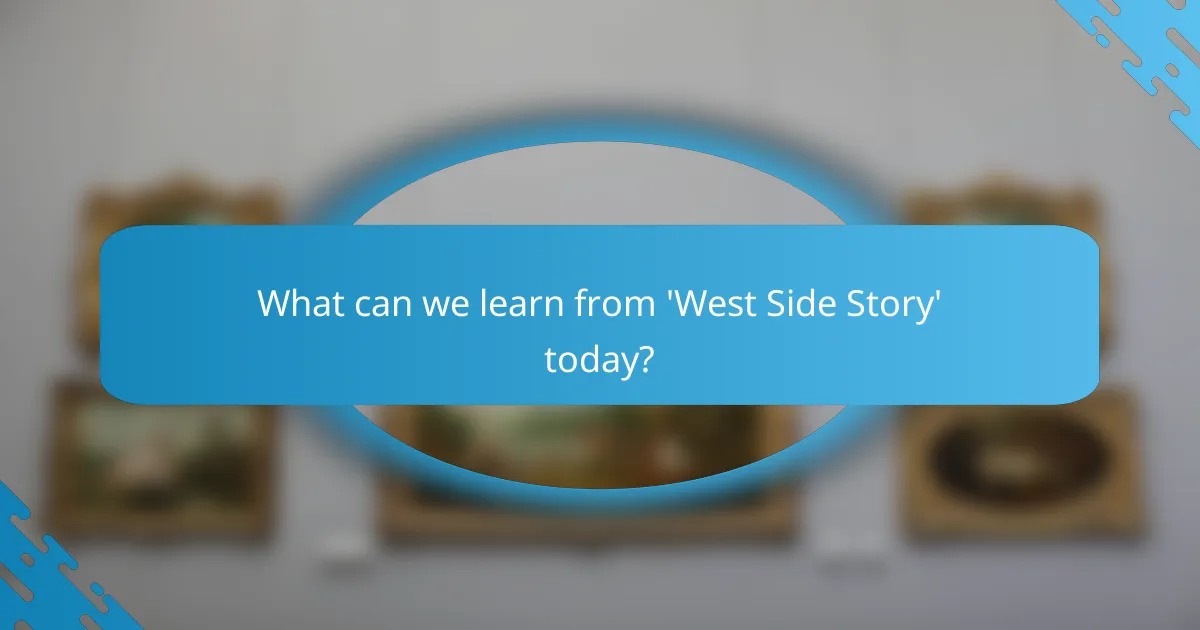
What can we learn from ‘West Side Story’ today?
‘West Side Story’ teaches us about the consequences of prejudice and violence. It highlights the impact of cultural conflict on relationships. The story emphasizes the importance of understanding and empathy. Through its characters, we learn about the struggles of marginalized communities. The musical’s themes remain relevant in today’s discussions on social justice. Its portrayal of love transcending barriers resonates with current societal challenges. The narrative encourages dialogue about acceptance and coexistence. Overall, it serves as a reminder of the importance of unity in diversity.
How can the themes of ‘West Side Story’ be applied to current societal issues?
The themes of ‘West Side Story’ can be applied to current societal issues such as racial tension and social inequality. The musical illustrates the conflicts between different cultural groups, mirroring contemporary issues of discrimination and division. The story’s focus on love transcending cultural barriers highlights the need for unity in today’s society. Additionally, the violence depicted reflects the real-world consequences of gang rivalry and systemic injustice. The musical’s exploration of identity and belonging resonates with ongoing discussions about immigration and acceptance. As such, ‘West Side Story’ serves as a relevant commentary on the challenges faced in modern communities.
What lessons about love and conflict can we take from ‘West Side Story’?
‘West Side Story’ teaches that love can transcend social and cultural barriers. The romance between Tony and Maria illustrates the power of love to challenge deep-seated prejudices. Their relationship highlights the tragic consequences of conflict fueled by hate and rivalry. The story reveals that societal divisions can lead to devastating outcomes, as seen in the characters’ fates. The musical underscores the importance of understanding and empathy in resolving conflicts. It shows that love can be a unifying force amidst violence and division. Ultimately, ‘West Side Story’ serves as a poignant reminder of the need for reconciliation and peace.
What are some best practices for studying ‘West Side Story’?
To study ‘West Side Story’ effectively, focus on its musical elements, themes, and cultural context. Analyze the score by Leonard Bernstein and lyrics by Stephen Sondheim to understand how music conveys emotion. Examine character development and relationships to explore themes of love and conflict. Consider the historical backdrop of 1950s America to appreciate its cultural reflection. Watch various productions to see different interpretations. Read critical essays and reviews to gain diverse perspectives. Engage in discussions or study groups to deepen understanding through collaboration. These practices enhance comprehension and appreciation of the musical’s complexity.
How can educators effectively teach the themes and music of ‘West Side Story’?
Educators can effectively teach the themes and music of ‘West Side Story’ by integrating multimedia resources. Utilizing film clips can illustrate the emotional depth of the music and themes. Discussing the historical context of the musical enhances understanding of its cultural significance. Engaging students in active listening exercises helps them analyze musical elements. Encouraging discussions about love and conflict can foster critical thinking. Incorporating performance activities allows students to experience the material firsthand. Assigning projects that explore character motivations deepens comprehension. Finally, connecting the themes to contemporary issues makes the content relatable and relevant.
What resources are available for deeper analysis of ‘West Side Story’?
Scholarly articles and books provide valuable resources for deeper analysis of ‘West Side Story’. For example, “West Side Story: A Cultural History” by Elizabeth L. Wollman explores its cultural impact. The journal “Theatre Journal” often features articles on musical theatre analysis, including ‘West Side Story’. Online databases like JSTOR and Google Scholar contain peer-reviewed papers on its themes and musical elements. Additionally, the documentary “Something’s Coming: West Side Story” offers insights into its creation and legacy. These resources collectively enhance understanding of the musical’s themes of love and conflict.
‘West Side Story’ is a pivotal entity in musical theatre, known for its innovative integration of music, dance, and storytelling. The article explores how the musical, created by Leonard Bernstein and Stephen Sondheim, revolutionized narrative techniques by addressing themes of love, conflict, and social division, particularly through its portrayal of cultural tensions between rival gangs, the Jets and the Sharks. Key musical elements, such as rhythm and orchestration, enhance the emotional depth of the characters and drive the narrative forward. The article also discusses the cultural reflection of the 1950s, examining issues of immigration, identity, and the impact of violence, while emphasizing the lasting influence of ‘West Side Story’ on contemporary musical theatre.
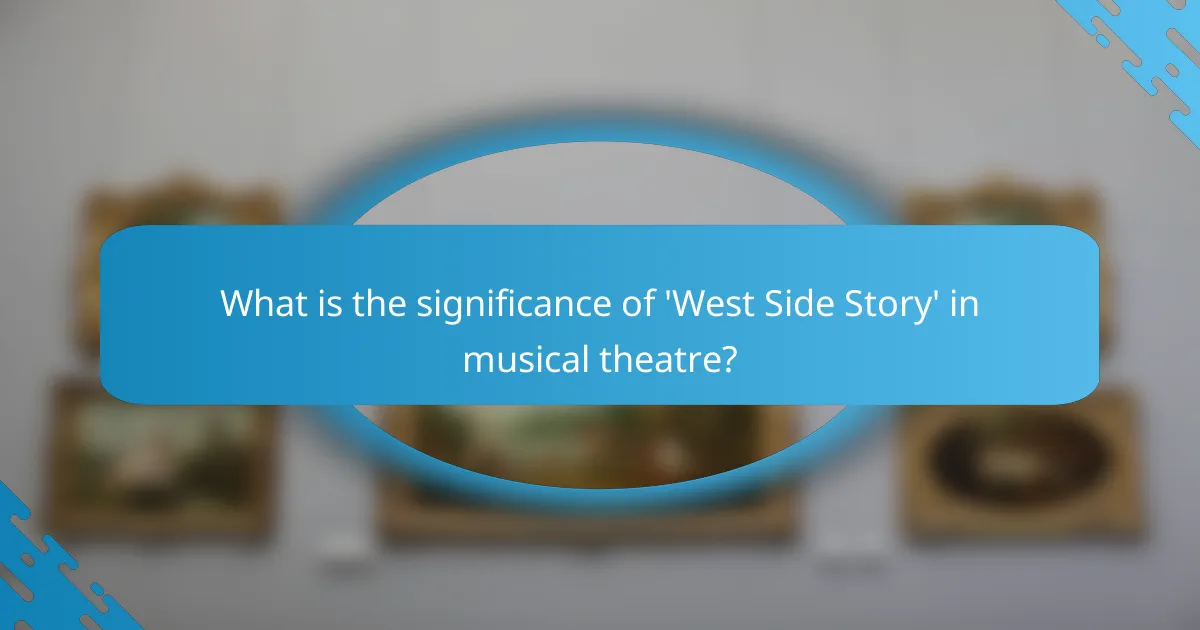
What is the significance of ‘West Side Story’ in musical theatre?
‘West Side Story’ is significant in musical theatre for its innovative integration of music, dance, and storytelling. The musical, created by Leonard Bernstein and Stephen Sondheim, premiered in 1957. It redefined the genre by addressing serious themes such as racism and love through a modern retelling of Romeo and Juliet. The use of ballet and jazz elements in choreography set a new standard for movement in musicals. Additionally, the score features iconic songs that have become standards in American music. The production’s impact on social issues and its reflection of urban life resonate even today. ‘West Side Story’ has influenced countless artists and remains a cornerstone of musical theatre history.
How did ‘West Side Story’ revolutionize musical storytelling?
‘West Side Story’ revolutionized musical storytelling by integrating dance, music, and narrative in a cohesive manner. It elevated choreography to a primary storytelling tool, reflecting character emotions and plot developments. The use of Leonard Bernstein’s complex score combined with Stephen Sondheim’s innovative lyrics added depth to the characters’ experiences. The musical addressed social issues such as racism and class conflict, making it relevant and impactful. Its structure broke away from traditional musical formats by incorporating a more dramatic and cohesive storyline. The characters were portrayed with psychological depth, enhancing audience connection. ‘West Side Story’ set a new standard for future musicals, influencing the genre significantly. This groundbreaking approach changed how stories could be told through music and dance.
What are the key musical elements that define ‘West Side Story’?
The key musical elements that define ‘West Side Story’ include its innovative use of rhythm, melody, and orchestration. The score, composed by Leonard Bernstein, features a blend of jazz, Latin, and classical influences. Syncopated rhythms create a sense of urgency and tension throughout the musical. Melodic lines often reflect the emotional states of the characters, enhancing the storytelling. The use of motifs represents different groups, such as the Jets and Sharks, adding depth to the narrative. Additionally, the integration of dance and music is crucial, with choreography by Jerome Robbins that complements the score. Overall, these elements work together to create a dynamic and emotionally resonant experience.
How do the musical elements enhance the narrative of ‘West Side Story’?
Musical elements enhance the narrative of ‘West Side Story’ by conveying emotions and advancing the plot. The score, composed by Leonard Bernstein, integrates various musical styles to reflect the characters’ backgrounds. For example, the use of jazz and Latin rhythms emphasizes the cultural divide between the Jets and Sharks. Songs like “Something’s Coming” express the anticipation and hope of the characters. The choreography, paired with the music, visually narrates the tension and conflict inherent in the story. Additionally, lyrical content reveals character motivations and inner struggles. The dramatic use of music during key scenes intensifies emotional impact, such as the haunting melodies in “Tonight.” Overall, these musical elements are crucial in deepening the audience’s understanding of the narrative and its themes.
What themes are explored in ‘West Side Story’?
‘West Side Story’ explores themes of love, conflict, and social division. The central love story between Tony and Maria highlights the power of love amidst adversity. Conflict arises from the rivalry between the Jets and the Sharks, representing broader social tensions. The musical also addresses issues of racism and cultural identity. Additionally, it reflects the impact of violence on communities. These themes are woven throughout the narrative, emphasizing the struggles of young people in a divided society.
How does ‘West Side Story’ portray the theme of love?
‘West Side Story’ portrays the theme of love through the intense relationship between Tony and Maria. Their love transcends the violent rivalry between the Sharks and the Jets. The musical illustrates love as both passionate and tragic. The iconic song “Tonight” expresses their hope and longing. Their love is depicted as pure, yet it faces societal obstacles. The tragic ending emphasizes love’s vulnerability amid conflict. This narrative showcases love’s power and fragility in a divided world. The story ultimately highlights love’s potential to inspire change, despite its challenges.
What conflicts are central to the storyline of ‘West Side Story’?
The central conflicts in ‘West Side Story’ are between rival gangs, the Sharks and the Jets. This rivalry stems from cultural and ethnic tensions. The Sharks represent Puerto Rican immigrants, while the Jets are a white American gang. Their conflict is exacerbated by territorial disputes in New York City.
Additionally, there is a personal conflict between Tony, a Jet, and Maria, the sister of the Sharks’ leader. Their love transcends gang boundaries but faces opposition from both groups. This romantic conflict highlights themes of love versus loyalty. The story ultimately explores the tragic consequences of these conflicts, leading to violence and loss.
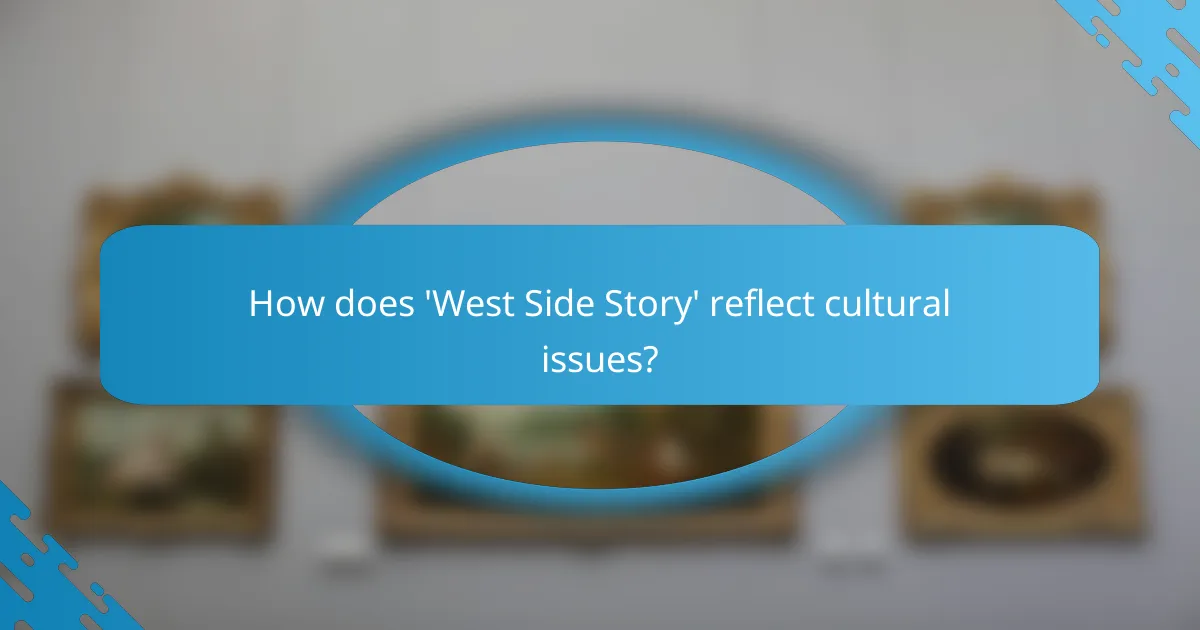
How does ‘West Side Story’ reflect cultural issues?
‘West Side Story’ reflects cultural issues through its portrayal of racial tension and social conflict. The musical highlights the struggles between the Jets and the Sharks, representing white and Puerto Rican communities. This conflict mirrors real societal issues of the 1950s, including immigration and discrimination. The characters face prejudice, showcasing the impact of cultural identity on personal relationships. Additionally, the use of music and dance emphasizes cultural expression and the clash of backgrounds. The narrative ultimately addresses themes of love, violence, and the desire for acceptance, making it a poignant commentary on cultural divides.
What social issues are highlighted in ‘West Side Story’?
‘West Side Story’ highlights social issues such as racism, gang violence, and immigration. The narrative contrasts the lives of two rival gangs, the Sharks and the Jets. This rivalry is rooted in ethnic tensions, showcasing the discrimination faced by Puerto Ricans in America. The musical also addresses the impact of violence on communities. Characters experience loss and heartbreak due to gang conflicts. Additionally, the story reflects the struggles of immigrants seeking acceptance. These social issues are interwoven throughout the plot, illustrating their relevance in society.
How does the setting of ‘West Side Story’ contribute to its cultural commentary?
The setting of ‘West Side Story’ plays a crucial role in its cultural commentary by highlighting urban conflict and social divisions. The backdrop of 1950s New York City serves as a microcosm of American society. It showcases the tensions between different ethnic groups, primarily the Puerto Rican Sharks and the American Jets. This setting reflects real historical issues of immigration and assimilation faced by minority communities.
The use of the cityscape reinforces themes of displacement and belonging. The characters navigate a landscape marked by violence and prejudice. This environment amplifies the tragic consequences of their rivalry, illustrating the impact of systemic social issues. The gritty urban setting contrasts with the idealized notion of love, emphasizing the barriers that exist in society.
Overall, the setting is integral to understanding the cultural commentary of ‘West Side Story,’ as it frames the narrative within the context of real societal struggles.
In what ways does ‘West Side Story’ address immigration and identity?
‘West Side Story’ addresses immigration and identity through its portrayal of rival gangs, the Jets and the Sharks. The Sharks represent Puerto Rican immigrants, highlighting their struggles and cultural identity. The musical illustrates the challenges immigrants face in adapting to a new society. It also showcases the clash of cultures and the desire for acceptance. The characters’ experiences reflect broader themes of prejudice and belonging. For example, Maria’s relationship with Tony symbolizes hope for unity amid cultural divides. The narrative emphasizes the impact of immigration on personal identity and community dynamics.
How has ‘West Side Story’ influenced contemporary musical theatre?
‘West Side Story’ has profoundly influenced contemporary musical theatre through its innovative integration of music, choreography, and narrative. The show introduced a sophisticated blend of classical music and jazz, setting a new standard for musical composition. Its use of dance as a storytelling device has inspired numerous productions to prioritize choreography in conveying emotion and plot.
Additionally, ‘West Side Story’ addressed social issues such as race and identity, encouraging future musicals to tackle complex themes. The emotional depth of its characters paved the way for more nuanced portrayals in later works. The show’s success demonstrated the potential for musicals to engage with serious subject matter while still appealing to mainstream audiences.
Its legacy includes the adoption of a more cinematic approach to staging, influencing the visual style of contemporary productions. Overall, ‘West Side Story’ reshaped the landscape of musical theatre, blending artistry with cultural commentary.
What elements from ‘West Side Story’ are still prevalent in modern musicals?
Key elements from ‘West Side Story’ that are prevalent in modern musicals include the integration of dance, complex character development, and themes of social conflict. The use of dance as a storytelling device enhances emotional expression and narrative progression. Modern musicals often feature diverse musical styles, reflecting the cultural backgrounds of characters, similar to how ‘West Side Story’ blends classical and jazz influences. Additionally, the exploration of love across cultural divides remains a significant theme in contemporary works. The portrayal of societal issues, such as racism and class struggle, continues to resonate, paralleling the conflicts faced by characters in ‘West Side Story’. These elements have influenced numerous modern productions, demonstrating the lasting impact of this classic musical.
How has ‘West Side Story’ inspired new generations of artists?
‘West Side Story’ has inspired new generations of artists through its innovative blend of music, dance, and storytelling. The musical redefined the Broadway landscape with its contemporary themes and complex characters. Its exploration of love and conflict resonates with modern audiences. Artists draw from its choreography to create dynamic performances. The score, composed by Leonard Bernstein, remains influential in musical theater. The narrative tackles social issues, encouraging artists to address similar themes in their work. The film adaptation reached a wider audience, further solidifying its impact. Numerous revivals and adaptations have kept its spirit alive in contemporary culture.
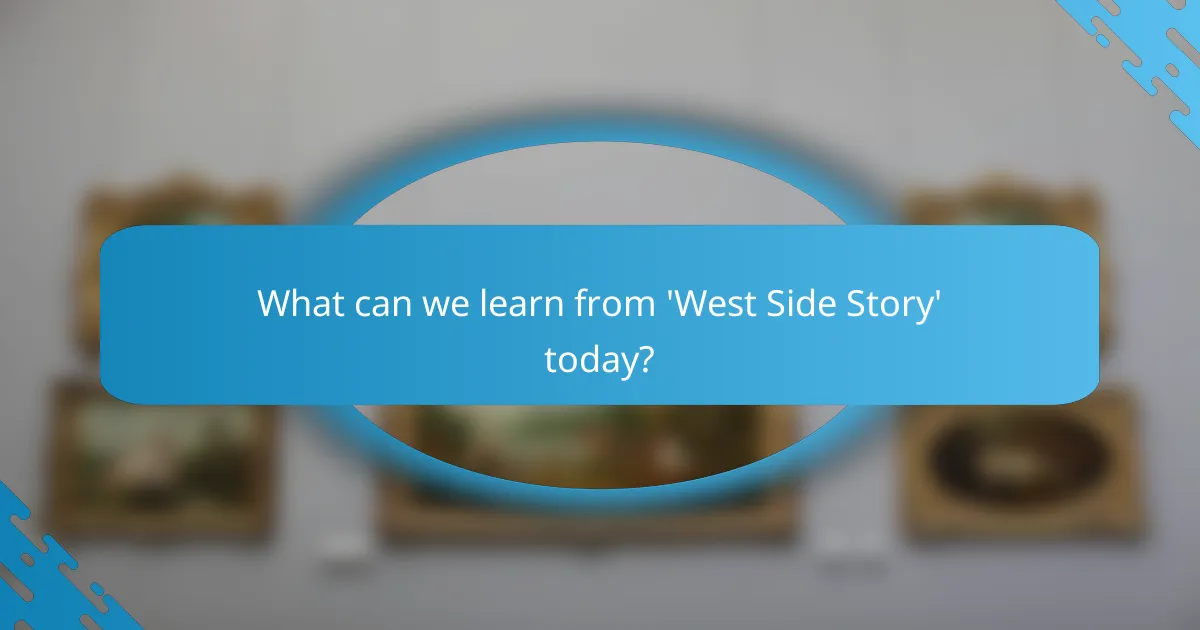
What can we learn from ‘West Side Story’ today?
‘West Side Story’ teaches us about the consequences of prejudice and violence. It highlights the impact of cultural conflict on relationships. The story emphasizes the importance of understanding and empathy. Through its characters, we learn about the struggles of marginalized communities. The musical’s themes remain relevant in today’s discussions on social justice. Its portrayal of love transcending barriers resonates with current societal challenges. The narrative encourages dialogue about acceptance and coexistence. Overall, it serves as a reminder of the importance of unity in diversity.
How can the themes of ‘West Side Story’ be applied to current societal issues?
The themes of ‘West Side Story’ can be applied to current societal issues such as racial tension and social inequality. The musical illustrates the conflicts between different cultural groups, mirroring contemporary issues of discrimination and division. The story’s focus on love transcending cultural barriers highlights the need for unity in today’s society. Additionally, the violence depicted reflects the real-world consequences of gang rivalry and systemic injustice. The musical’s exploration of identity and belonging resonates with ongoing discussions about immigration and acceptance. As such, ‘West Side Story’ serves as a relevant commentary on the challenges faced in modern communities.
What lessons about love and conflict can we take from ‘West Side Story’?
‘West Side Story’ teaches that love can transcend social and cultural barriers. The romance between Tony and Maria illustrates the power of love to challenge deep-seated prejudices. Their relationship highlights the tragic consequences of conflict fueled by hate and rivalry. The story reveals that societal divisions can lead to devastating outcomes, as seen in the characters’ fates. The musical underscores the importance of understanding and empathy in resolving conflicts. It shows that love can be a unifying force amidst violence and division. Ultimately, ‘West Side Story’ serves as a poignant reminder of the need for reconciliation and peace.
What are some best practices for studying ‘West Side Story’?
To study ‘West Side Story’ effectively, focus on its musical elements, themes, and cultural context. Analyze the score by Leonard Bernstein and lyrics by Stephen Sondheim to understand how music conveys emotion. Examine character development and relationships to explore themes of love and conflict. Consider the historical backdrop of 1950s America to appreciate its cultural reflection. Watch various productions to see different interpretations. Read critical essays and reviews to gain diverse perspectives. Engage in discussions or study groups to deepen understanding through collaboration. These practices enhance comprehension and appreciation of the musical’s complexity.
How can educators effectively teach the themes and music of ‘West Side Story’?
Educators can effectively teach the themes and music of ‘West Side Story’ by integrating multimedia resources. Utilizing film clips can illustrate the emotional depth of the music and themes. Discussing the historical context of the musical enhances understanding of its cultural significance. Engaging students in active listening exercises helps them analyze musical elements. Encouraging discussions about love and conflict can foster critical thinking. Incorporating performance activities allows students to experience the material firsthand. Assigning projects that explore character motivations deepens comprehension. Finally, connecting the themes to contemporary issues makes the content relatable and relevant.
What resources are available for deeper analysis of ‘West Side Story’?
Scholarly articles and books provide valuable resources for deeper analysis of ‘West Side Story’. For example, “West Side Story: A Cultural History” by Elizabeth L. Wollman explores its cultural impact. The journal “Theatre Journal” often features articles on musical theatre analysis, including ‘West Side Story’. Online databases like JSTOR and Google Scholar contain peer-reviewed papers on its themes and musical elements. Additionally, the documentary “Something’s Coming: West Side Story” offers insights into its creation and legacy. These resources collectively enhance understanding of the musical’s themes of love and conflict.
